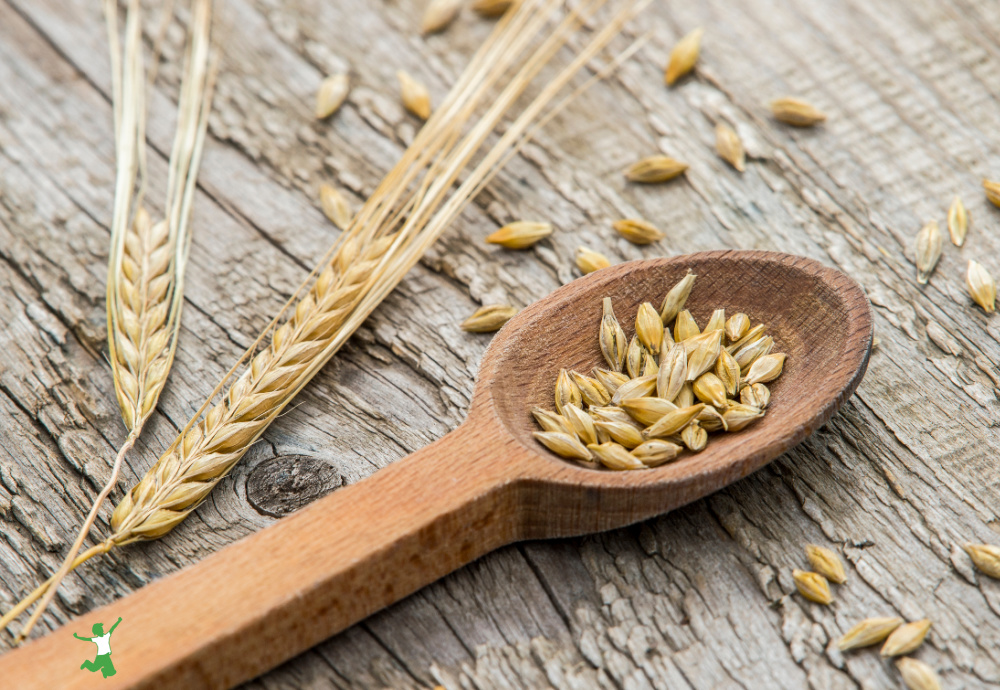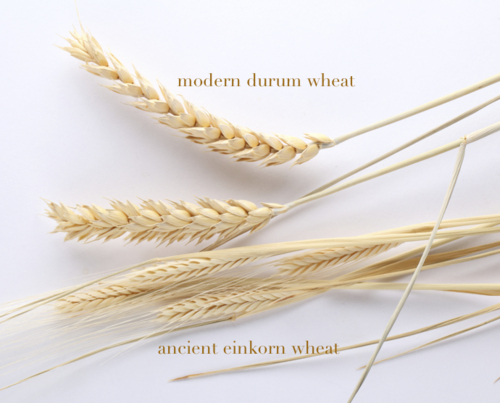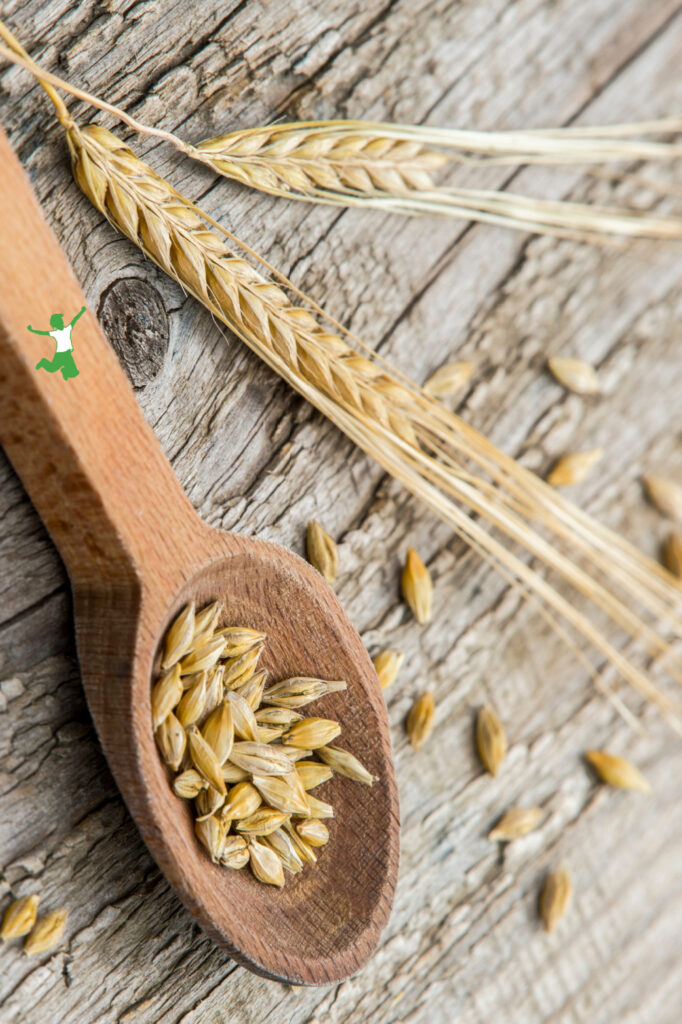There are four big reasons why einkorn is, by far, the best form of wheat to eat even when compared to other ancient grains like spelt, emmer, and kamut.

Most people who love to bake bread, pastries, and other goodies do not realize that einkorn is the best type of wheat to use.
Twenty-five or so years ago, I used to purchase organic white wheat (hard and soft) and spelt in bulk from a local grain co-op for my baking endeavors.
Grinding grain into fresh flour is certainly the most nutritious and tastiest way to bake! I also did this to avoid the conventional toxic wheat desiccated with gut-destroying glyphosate.
Caveat: Baking with freshly ground flour is only better if the bread is traditionally prepared.
Otherwise, the antinutrients like phytic acid are not broken down and harm to gut health is likely over time.
There certainly is a huge difference between modern processed wheat (hybridized by irradiation) and the organic, ancient grains you grind yourself at home.
I remember when I was breastfeeding my youngest child, if I ate so much as a mouthful or two of processed wheat at a restaurant, she would spit up for one or sometimes even two days!
If I ate organic wheat that I ground myself and either sprouted, soaked, or sour-leavened (sourdough), however, she never had any spit-up issues.
To me, this was a huge testament to the radically improved digestibility of wheat that is prepared using the wise methods of ancestral cultures.
Beware of persuasive influencers who claim that all you need to do is grind freshly ground flour and bake bread with baker’s yeast with no proper preparation such as soaking, sprouting or sour-leaving the dough necessary.
This approach is not how traditional societies ever baked their bread, and it is a recipe for serious gut issues!
Most people do not know that baker’s yeast is actually a modern invention only used in the past few centuries!
It quickly gained traction because it made baking faster and easier (NOT healthier). This is the case even when using freshly ground flour!
These quick rise breads using baker’s yeast gradually displaced traditional sourdough to the detriment of those who embraced this early “modern” cooking convenience.
Einkorn Benefits over Modern Wheat
With traditional baking the way to go (using a sourdough starter and NOT baker’s yeast), let’s talk about einkorn as the best type of wheat to bake with.
There are four reasons why I prefer to bake with einkorn wheat and no other type of ancient grains.
This isn’t to say I never use anything else, but if given the choice, I prefer to use einkorn.
Note that einkorn is not to be confused with farro or heirloom wheat.
Better Taste
My first experience baking with einkorn occurred after I received a thoughtful gift of, among other things, einkorn flour and wheat berries. I was delighted when I ground the einkorn into flour and saw how light and white it was.
I am not a fan of bran and am not of the food philosophy that all that fiber is actually good for your gut.
Fiber is a band-aid that covers up the root causes of constipation, a very common symptom of gut imbalance.
I recommend the book Fiber Menance as a good read on the subject.
The truth is that the unhybridized form of wheat…einkorn is the only one…does not have that much bran!
I was thrilled to see that my family thoroughly enjoyed the soaked waffles made with freshly ground einkorn flour.
Later on, I learned to make sprouted einkorn waffles that were more convenient but still highly digestible.
From that point, I gradually incorporated using einkorn for all my baking needs including this very popular no knead sourdough bread recipe.
Most Digestible
Because einkorn is unhybridized and low in bran, it is the most digestible form of wheat you can eat.
While my properly prepared grain dishes made with white wheat or spelt digest fine for our family, you can tell that the same dishes make with einkorn feel even better in the stomach.
This is possibly because einkorn contains good gluten, different on a molecular level from modern gluten in all other forms of wheat including ancient grains like spelt.
Better digestion means better absorption of nutrients, so einkorn surpasses the competition in that category as well.
Visually Distinctive

The first thing I noticed when I ground einkorn into flour for the first time was how much smaller a grain of einkorn is compared with a grain of modern wheat. They are about half the size!
In addition, I noticed that my grain grinder makes less noise when grinding einkorn berries into fresh flour because of softer, low bran kernels.
The distinctive crease on one side of a grain of modern wheat is also absent from kernels of einkorn.
The reason for the differences is that over the centuries, the genetics of wheat gradually changed due to human cultivation practices.
Year after year, farmers selected the seeds at harvest time that suited the goal of higher yields and MORE gluten.
This worked best for big farms and larger-scale agriculture, production, and distribution of wheat products.
The ONLY Unhybridized Wheat

Einkorn is like most plants in that it is diploid.
This means that einkorn contains only 2 sets of chromosomes.
About 2,000 years after einkorn wheat, nature created emmer via the natural hybridization of 2 wild grasses.
Consequently, emmer has 4 sets of chromosomes. Kamut and durum (bulgur) wheat are both descendants of emmer.
Spelt, an heirloom wheat, is the result of hybridization between cultivated emmer and another wild grass. Thus, spelt contains six sets of chromosomes.
Modern wheat is a descendant of spelt.
As you can see, einkorn is the purest and most ancient form of wheat available. With only 2 sets of chromosomes, a very different composition of gluten, and low bran, it is the most digestible form of wheat for baking at home.
Where to Source Quality Einkorn
The only downside of einkorn is that it is not widely available and tends to be more expensive than other types of wheat. It is still quite new to the North American market.
If you are sourcing organic einkorn berries, I recommend this quality brand.
If you need organic sprouted einkorn berries for more convenient baking, this farm based in the United States is my preferred source.
Have you tried einkorn wheat yet? If so, what observations have you made about this ancient, unhybridized wheat?









HI, I HAVE READ DR. WILLIAM DAVIS BOOK, WHEAT BELLIES, AND YOUR REPORT OF THE EINKORN WHEAT IS EXACTLY RIGHT, BECAUSE HE SAID IT’S BECAUSE OF ALL OF THE HYBREDSATION (IF THAT IS CORRECT) THAT THIS IS WHY SO MANY PEOPLE ARE GETTING CELIAC, HIGH COLESTEROL, EXCESSIVE WEIGHT , ETC, BECAUSE THEY HAVE CHANGED THE WHEAT SO MUCH, WITHOUT EVER HAVING TESTED IT IN THE HUMAN BODY. WHERE CAN I GET THIS ORIGINAL UNMODIFIED WHEAT? THANK YOU!
See my Resources page … this is where I buy it. https://www.thehealthyhomeeconomist.com/resources/#flours
Hi,
I’ve really been enlightened here about first sifting freshly ground flour before using it. However, if I’m making bread, what is the process for soaking? I’m guessing that after grinding and sifting, I then mix the flour with the water portion, and then after it’s soaked about 8 hours or more, I then go ahead and add the yeast and then let it start it’s first proofing session? Or, is the fermenting process on its own enough to deactivate the anti-nutrients? Thank you!
ANCIENT ISRAELI GRAINS
The 5 Grains of Israel were mistranslated over the 2,000 years of Exile in Europe. Only grains that are indigenous to the Land of Israel are the authentic 5 Israeli Grains, as explained in the Mishnah Hallah 1:1:
שיפון Shippon (shifon) — einkorn wheat (T. monococcum),
כוסמין Kusmin — emmer wheat (T. dicoccon),
×—×™×˜×™× á¸¤ittim — durum wheat (T. durum) and bread wheat (Triticum aestivum),
×©×¢×•×¨×™× Se’orim — six row barley (Hordeum vulgare), and
שיבולת שועל Shibbolet shual — two row barley (Hordeum vulgare).
If someone is celiac, they should NOT eat any type of wheat, even ancient israeli Shippon (T. monococcum) aka Einkorn. Be in touch for details.
Eli Rogosa
growseed.org
Heritage Grain Conservancy
Hi,
I have a friend, who’s Celiac, and who lives in Israe’l.
Since she’s Jewish, and should theoretically make a special blessing on the Sabbath and Jewish Holy Days over bread made from the 5 main grain types, which ever grew there (wheat, rye, barley, oat – and one other I forgot), she’s forever looking to find a flower from one of these grains, that has the gluten taken out of them.. Years ago, she was able to get a such a flour made from wheat from a Swiss company, but they don’t make it anymore.
So now, she’s looking again for ages already to find something like that.
I would like to send her a package with organic wholemeal Einkorn flour, to try it out, but if she doesn’t have symtoms after eating the bread made with it, should she then go to her doctor, to check, if it nonetheless destroys her intestine? Can a doctor at all find out, if that’s the case?
What to do? Does anyone have knowledge about this?
Thank you in advance!
Thanks for the great info on Einkorn! I’ve been wanting to try it. I noticed your statement that no GMO wheat is sold in North America. Some believe is it, secretly. I’m no conspiracy theorist, but I have come across articles like this that do make me wonder:
http://www.kingarthurflour.com/flours/gmo-wheat.html
I’ll be ordering Einkorn from the supplier you use. Excited to try it!
Hi Sarah,
I my humble opinion you are playing a very dangerous game allowing any gluten in your diet regardless of the quality of einkorn. If you have multiply auto immune conditions then you are clearly gluten sensitive and that requires a ZERO gluten approach. Not even small grains of gluten.
Gluten in your diet will continue to stimulate memory B cells which prime your immune system to continue its onslaught on your own tissue. Cyrex labs do four panels which will tell a) is my gut leaking b) how many gluten antibodies am I making c) which foods cause gluten cross reactions and d) they have a panel that identifies which tissue your immune system is attacking. Very useful.
Regards Gary
Haven’t tried Einkorn yet, but I will soon. My local co-op here in Sierra Vista, AZ now carries organic berries in their bulk section for $4.29/lb. I’ll cook them the same way I cook wheat or rye berries but I wondered if you had to have a grain mill to grind into flour. If I’m just grinding a very small amount can I use a coffee grinder or will that not make it fine enough to bake with? Thanks!
So, I’m good with the soaking and switching, etc. but my main question is, in your opinion, what am I to do about digestible pasta for my family? Jovial makes pasta but it’s not sprouted. Am I stuck with Ezekial 4:9’s limited options? Should I just move on from pasta? I really don’t think that with a newborn anyday now and a 16 month old that I am going to take on the newest task of pasta making right now… =) Thanx for your help!